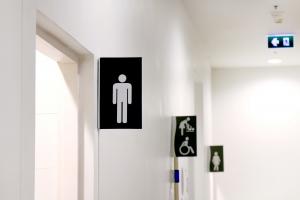Understanding ADA-Compliant Restroom Design: Plumbing Standards for Commercial Properties
Stephen Jordan, owner of SMJ Plumbing in New Orleans, emphasizes that ADA compliance in commercial restrooms extends far beyond general building codes.
"Designing an ADA-compliant restroom means more than just choosing accessible fixtures. It requires exact measurements, proper spacing, and consideration of how the plumbing system supports both function and accessibility,” said Jordan.
Minimum Clearances and Access Requirements
ADA standards mandate that restrooms be accessible to individuals using wheelchairs or other mobility aids. This includes providing clear floor space for maneuvering—typically a 60-inch turning radius—and unobstructed paths to fixtures. Access to the sink, toilet, and other features must be free of obstructions such as pipes, partitions, or cabinetry that would hinder use.
To accommodate these needs, the following clearances are generally required:
A minimum of 30 inches by 48 inches of clear floor space in front of sinks, toilets, and urinals
A 60-inch diameter turning space inside single-user restrooms
Doors that swing outward or provide additional clearance when opening inward
At least one accessible stall in multi-user restrooms with compliant dimensions and fixtures
Lavatories and Sink Installations
Sinks must meet several specific ADA requirements regarding height, clearance, and hardware:
The top of the sink or lavatory must not exceed 34 inches from the finished floor
A minimum of 27 inches of vertical clearance must be provided for knee space beneath the sink
Pipes under the sink must be insulated or otherwise configured to protect against contact
Faucets must be operable with one hand, without requiring tight grasping, pinching, or twisting of the wrist
Mounting heights, placement from walls, and horizontal reach ranges must also be considered to ensure that controls, soap dispensers, and hand dryers can be accessed by individuals seated in a wheelchair.
Toilet and Stall Configurations
Toilet compartments are a primary focus of ADA regulations due to the physical challenges they often present. The following requirements apply to accessible stalls:
Centerline of the toilet must be 16 to 18 inches from the adjacent wall
Toilet seat height must range from 17 to 19 inches above the finished floor
Grab bars must be securely mounted behind and beside the toilet at regulated heights and lengths
Flush controls must be located on the open side of the toilet and operable without tight grasping
Stalls must also provide space for a wheelchair to approach and transfer, with doors that are easily operable and wide enough for clear entry.
Urinals and Additional Fixtures
In facilities that provide urinals, at least one must be ADA-compliant. This involves mounting the urinal at no more than 17 inches above the finished floor and allowing for a clear floor space in front of the unit. Flush controls must be mounted at or below 44 inches and accessible from a forward approach.
Other fixtures—such as baby changing stations, trash receptacles, and paper towel dispensers—must also be installed within accessible reach ranges to avoid obstructing access routes or reducing the effectiveness of an otherwise compliant restroom.
Drinking Fountains and Other Plumbing Features
Where drinking fountains are provided, at least one must be accessible to individuals with disabilities. The spout must be no more than 36 inches from the floor, positioned for a forward approach, and located at least 15 inches from the wall. Controls must be operable with minimal force and without requiring precise finger movements.
Restroom accessories and additional features like emergency alarms, occupancy indicators, and shutoff valves must also comply with ADA guidelines depending on the occupancy and building type.
Renovations and Retrofit Considerations
For existing buildings undergoing renovation or partial upgrades, ADA compliance still applies. Facilities must remove barriers where readily achievable, which includes modifying restrooms and fixtures that are not currently compliant. This process often requires careful planning to ensure that plumbing systems, fixture spacing, and structural elements are properly adapted to meet modern requirements.
Working with licensed plumbers who understand ADA standards helps ensure that modifications meet both local code and federal accessibility laws.
Morgan Thomas
Rhino Digital, LLC
+1 504-875-5036
email us here
Visit us on social media:
Facebook
Legal Disclaimer:
EIN Presswire provides this news content "as is" without warranty of any kind. We do not accept any responsibility or liability for the accuracy, content, images, videos, licenses, completeness, legality, or reliability of the information contained in this article. If you have any complaints or copyright issues related to this article, kindly contact the author above.
Wine and Beverage Refrigerator Market USD 4.63 Billion by 2032, at 5.04% CAGR, Driven by Changing Consumer Lifestyles
EBC Financial Group Strengthens LATAM Presence at iFX EXPO 2025, Reinforces Commitment to Inclusive Trading
EBC Financial Group Strengthens LATAM Presence at iFX EXPO 2025, Reinforces Commitment to Inclusive Trading
Kalendarium
Więcej ważnych informacji
 Jedynka Newserii
Jedynka Newserii

 Jedynka Newserii
Jedynka Newserii

Prawo

Kwestie bezpieczeństwa priorytetem UE. Polska prezydencja ma w tym swój udział
– Polska prezydencja skierowała oczy Europy na obronność – przekonuje Magdalena Sobkowiak-Czarnecka z KPRM. Większość europejskich państw jest zgodna, że najważniejszą kwestią jest obecnie finansowanie bezpieczeństwa i obronności. Jednym z priorytetów białej księgi w sprawie obronności europejskiej będzie Tarcza Wschód, która obejmuje umocnienia wzdłuż wschodniej i północnej granicy Polski.
Problemy społeczne
Duża zmiana w organizacji pracy w firmach. Elastyczność wśród najważniejszych oczekiwań pracowników

Dotychczasowe modele organizacji pracy w firmach nie zawsze odpowiadają na wyzwania przyszłości. Ostatnie lata zmieniły zasady gry na rynku pracy i teraz elastyczność liczy się na nim bardziej niż kiedykolwiek wcześniej. Elastyczny model pracy staje się jednym z bardziej oczekiwanych benefitów, a dla firm jest to sposób na przyciągnięcie talentów. Kolejnym jest wykorzystanie innowacyjnych narzędzi technologicznych. To jednak wymaga zarówno od pracowników, jak i od pracodawców zaangażowania w ciągłe podnoszenie kompetencji.
Motoryzacja
Pożary pojazdów elektrycznych są rzadsze niż spalinowych. W powszechnym przekonaniu jest odwrotnie, bo brakuje edukacji

Trzydzieści pożarów aut elektrycznych i niemal 9,5 tys. pożarów aut spalinowych – to statystyki za ubiegły rok. Jak podkreślają eksperci, statystycznie pojazdy elektryczne płoną rzadziej niż spalinowe. W przeliczeniu na tysiąc zarejestrowanych pojazdów wskaźnik pożarów w przypadku elektryków wynosi 0,372, a w przypadku aut spalinowych 0,424. Specjaliści są zgodni co do tego, że w powszechnym obiegu brakuje rzetelnej wiedzy na temat samochodów elektrycznych i ich bezpieczeństwa pożarowego.
Partner serwisu
Szkolenia

Akademia Newserii
Akademia Newserii to projekt, w ramach którego najlepsi polscy dziennikarze biznesowi, giełdowi oraz lifestylowi, a także szkoleniowcy z wieloletnim doświadczeniem dzielą się swoją wiedzą nt. pracy z mediami.





![Dramatyczna sytuacja w opiece długoterminowej. Kolejki oczekujących są coraz dłuższe [DEPESZA]](https://www.newseria.pl/files/1097841585/opieka-nfz-still-1,w_85,_small.jpg)



.gif)

 |
| |
| |
|